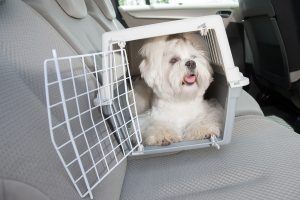Keeping Your Dog Safe In The Car
 Michael Babboni
Car Accidents
Our dogs aren’t just pets, they are part of the family. So it is no wonder so many people love to take them for rides in the car. However, driving with dogs can be risky if you are not careful.
Michael Babboni
Car Accidents
Our dogs aren’t just pets, they are part of the family. So it is no wonder so many people love to take them for rides in the car. However, driving with dogs can be risky if you are not careful.Unrestrained pets cause more than 30,000 accidents annually, according to the American Automobile Association, and the Travel Industry Association of America says 29 million Americans have traveled with a pet on a trip of 50 miles or more in the past five years. With those kinds of numbers, it's important to remember that pets have special needs on the road.
Restrain Your Dog
While dogs want to be free, keeping them in place keeps them safer.
Unrestrained pets can be a distraction to drivers and can get injured if the car makes a sudden stop or is involved in an accident even at low speeds. Where you put the dog doesn’t guaranteed safety either if they are allowed to roam around the vehicle. The best way is to simply secure your pet in a crate or with a harness to keep them safe.
Occasionally, having others in the vehicle can greatly help you manage the dog and its whereabouts in the vehicle. However, it can still be a huge risk, especially with big dogs that can be too much for a single or even several people to manage.
Don't Put Your Dog On Your Lap
One of the biggest hazards, not only to pets but also to their owners and even other drivers, is the drivers who insists on keeping Spot on their lap. This makes it impossible for drivers to respond immediately to road emergencies.
Not to mention that the dog can also be hit by passing cars if it bolts out of the vehicle after a crash.
The issue has gained attention in recent years as the issue of distracted driving increases the risk of car accidents everywhere. In 2009, 5,474 people were killed and 448,000 injured in crashes caused by distracted drivers in the United States, according to the National Highway Traffic Safety Administration, although it's difficult to assign the number of those where pets were involved. In perhaps one of the most famous incidents of distracted driving involving a pet, author Stephen King suffered several broken bones and a collapsed lung in 1999 when he was hit by a driver who claimed he was distracted by his dog.
A Few Helpful Tips To Keep In Mind
- Don't let dogs ride with their head out of the window. They can easily be injured by debris flying into their eyes.
- Get your pet used to the car and make them feel comfortable. Often, the only time pets ride in the car is when they're visiting the vet, so they may not always associate a car ride with positive feelings and may even be afraid to ride in the car. Take them to a nearby park or other fun area where it will be a short and easy drive before any long trips.
- Make sure your pet has proper identification. Just in case they gets lost while traveling, you want to be sure your pet is wearing up-to-date ID tags with an emergency contact phone number.
- Prepare a doggie bag. Make sure it contains clean-up supplies, a towel, portable feeding/watering bowls, food and water, a pet first aid kit, and toys to keep them busy and well behaved.
- Don’t allow them to move all over the car! Just a little shift in position is fine, but moving from the front seat to the back and from one lap to another is not okay.
